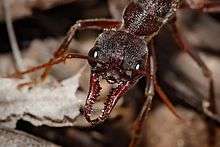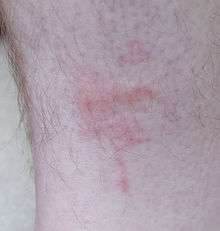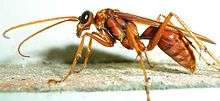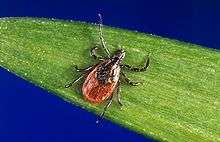Pests
Travellers may encounter animal pests that they are not familiar with in their home regions. Pests can spoil food, cause irritation, or in a worse case cause allergic reactions, spread venom, or transmit infections. Infectious diseases themselves, or dangerous animals that can injure or kill people by force, do not usually qualify as pests. There is a separate article on poisonous plants.
- Wikivoyage articles have a Stay Healthy section with location-specific advice. This article contains general information relevant to many destinations.
Prepare
| “ | Those who sleep with dogs will rise with fleas. | ” |
—International proverb | ||
Pests behave differently. Among high-risk locations are low-income urban neighbourhoods, tropical regions, wetlands, stagnant bodies of water, and high vegetation. Food and animal feed tend to attract pests.
In general, pests are more prolific during warm and wet seasons; especially insects, which reproduce fast.
Animals
Ants
The common black ants are a problem mainly because they get into food. However, there are types of ants that can make for an uncomfortable or even dangerous encounter. The three types of stinging ants are:

- Bull ants - around 90 species of ant endemic to Australia and New Caledonia, identified by their slender bodies 15-40 mm long, large eyes, and long mandibles
- Fire ants - 285 species worldwide, typically with black-reddish bodies, 2-6 millimeters in length
- Ponerine ants - 1,600 species worldwide, which can be identified by a very constricted "waist" and large body size
Ant stings can really hurt, and accidentally walking on a fire ant nest can give a person - especially a toddler - an experience they won't soon forget. Though painful, bites will usually clear up within a couple of days if left alone. For cases where there are multiple bites, hydrocortizone or aloe vera is sometimes applied topically, or antihistamines may be taken orally. A few unfortunate people are allergic, and for such people stings may lead to anaphylactic shock, which can be lethal.
#Permethrin-treated_fabrics kill ants, as well as other insects, that crawl on them.
Bedbugs

These tiny nuisances tend to nest under beds or in other furniture, coming out at night to feed on the blood of unsuspecting victims who typically do not feel bites at the time. Infestation can be found almost anywhere in the world - they are most common in less developed areas but are becoming an increasingly common problem in the developed world as well. Bites are typically nothing serious and may be hardly noticeable, but can sometimes provoke rashes, allergic reactions, or other skin irritations. If you are travelling cheap and happen to detect a faint odor of rotten raspberries in your hotel room, or if you find small, mysterious red bites on your skin in the morning, you might consider changing your choice of accommodations. Sleep tight!
You do not want to take these home with you. Avoid unpacking into places where the bugs may be dwelling and wash your spare clothes before the bugs have a chance to hide away.
#Permethrin-treated_fabrics kill bedbugs. Treating items like your sleeping bag or pajamas can partially protect you from bites, and treating your backpack can prevent them getting into spare clothes.
Bees, hornets and wasps

Hornets and wasps sting more readily than bees because stinging is a simpler act, and they can sting multiple times. Wasp stings can be very painful, but unless you are allergic to the stings of any of these insects, are stung near the trachea (such as easily if you get one in the mouth) or are stung by an entire hive, there is usually very little risk of serious complications. However, varieties such as the 'Asian Giant Hornet' (found in Japan, Korea and China) can be extremely dangerous, even to people without an allergy. Yellowjackets, though similar to bees in appearance, are actually a type of wasp. They probably won't sting you for no reason, but if you are eating or drinking outside and a swarm of yellowjackets decides they want what you're having, you're best off letting them have it.
| WARNING: People who are allergic to bee stings need to exercise great caution, because one sting can be fatal for them. Consult your doctor about carrying an epi pen for emergency first aid and other precautions. Consider using #Permethrin-treated_fabrics. | |
Centipedes
Chiggers
Cockroaches
Cockroaches are common carriers of disease and you surely do not want to handle them or allow them to get into your food. Quite a few people are allergic to cockroaches, and this allergy is a major cause of asthma in places with large roach infestations, like poor areas of American cities. In some parts of the world, such as Thailand, large roaches called waterbugs are considered a delicacy and are for sale in markets for human consumption.
Fleas
Flies

It pays to check on what kind of flies are present where you are visiting. House flies can spread infection and are a common contaminator of food. In some countries exposed waste makes flies particularly dangerous by what they can spread.
Some types of flies bite but, unlike female mosquitoes, they have many sources of food other than blood, so they may leave you alone and be mostly just a nuisance. However, horseflies have a particularly annoying bite, and there are parts of the world where black flies are a horrible scourge. Even worse, certain types of flies are very dangerous, like the tsetse flies that spread sleeping sickness, which kills tens of thousands of people or more every year in East Africa. In Australia, non-biting flies can swarm and simply make it difficult to do anything without whisking them away from the face, leading to various nets and hat attachments as essential clothing.
#Permethrin-treated_fabrics kill flies, as well as other insects, that crawl on them.
Tiny biting flies (aka midges) are not unknown in remoter parts of the Scottish Highlands, Northern Europe, Scandanavia and Russia.
Jellyfish
- Main article: Jellyfish
Jellyfish are found the world over in many shapes and sizes. Some are harmless but many are venomous and will sting you. A few species are incredibly dangerous and in some cases can kill a human.
Leeches
Leeches are generally found in wet conditions. They catch on to you as you are brushing by plants, or attach to shoes in puddles. They will crawl to find bare skin, and attach to extract blood from you. After they have had their fill (a few hours) they will drop-off. They are not painful, and rarely result in severe consequences. The resulting bite can become infected, and attempts to remove them can do a fair bit of damage to your skin.
Again, a repellent including DEET applied to the legs, shoes, socks, is usually the best prevention.
Lice
Mites
Mites are similar to ticks and tend to be much smaller. They can be hard to see with the naked eye and be very uncomfortable if you are covered by some. See a doctor if you are affected.
Permethrin treated fabrics kill mites as well as other arthropods.
Mosquitoes

.png)

Mosquitoes exist around the world, especially in wetlands. In parts of the tropics, mosquitoes carry malaria, dengue fever, Zika virus, or yellow fever. Other diseases, including West Nile virus, can be spread by mosquitoes in some temperate latitudes. Swarms of mosquitoes can be a problem also where they do not carry diseases, and even a single mosquito bite can be an irritation and annoyance as it itches for days. Your body gets used to them over time, so bites itch much less for locals.
Prevention is better than cure: cover arms and legs as much as possible, and use repellents on exposed skin. There are mosquito hats (or nets to draw over your hat, which pack compactly), to use where the problem is severe. Insecticides that can be applied to fabrics are a good defense against mosquitoes as well as other insects, where these are a health problem. Use insect screens or insect nets where you sleep.
For areas where mosquitoes are known to carry diseases you should check in advance whether preventive medication is recommended. There are vaccines for yellow fever and dengue fever, but not for other mosquito-borne diseases. The vaccine against yellow fever has been around for decades now, whereas vaccines against dengue are still in the process of getting approved in most countries as of 2018. One vaccine, Dengvaxia, is available in a few countries, but has limited efficacy and is considered safe only for people who have previously been infected by dengue.
There are several drugs which will prevent malaria, but which one to use varies by region. Some of these drugs may be unsuitable for pregnant women or for people who react badly to a particular drug. In areas with lower malaria risks, taking preventive medicine can actually do more harm than good. Always talk to your doctor – or better yet, a specialist for tropical medicine – before traveling to any malaria endemic region.
In areas where mosquitoes are a problem, typical precautions include:
- insect repellent – topical lotions or sprays for both skin and clothing
- long sleeves and pants – loose fitting and light-colored in hot environments
- wearing white or bright clothing – black clothing attracts mosquitoes
- avoid perfume and scented products since those may attract mosquitoes
- mosquito nets – can be placed over your bed, hammock, or sleeping bag
- citronella candles or oil – emits a strong scent which may repel them
- staying inside at dawn or dusk – daybreak and nightfall are higher activity times for mosquitoes
Sleep in rooms that are either air-conditioned (so that you can close the windows and doors), or have insect screens over the windows, which will make it harder for mosquitoes to enter the room. Be sure to check the screens for defects before relying on them, and be quick at the door in the evening. Having a fan switched on can help, as the moving air makes it more difficult for mosquitoes to land.
Repellents are available in various forms, including lotions and aerosols that can be applied to the skin, and others that can be applied to clothing. There are also devices that generate repelling scent, such as mosquito coils and citronella candles.
- DEET (diethyl toluamide) – effective at concentrations of 10% and up; its strength plateaus at around 50%, and the efficacy–safety balance is probably best at 30%. DEET-based repellents are generally the most common, the most effective overall, and are readily available from pharmacies, supermarkets, and vendors at larger airports. DEET should not have harmful effects when applied to the skin as instructed, but don't inhale it (or drink it). If you need repellents for an extended time, recommendations for minimizing absorption may be relevant. DEET on your skin plus permethrin on your clothes is a highly effective combination.
- Picaridin (icaridin) – for those sensitive to DEET, or who dislike its smell, repellents containing Picaridin (e.g., Cutter Advanced) are available in limited areas. These have been shown to be as effective as DEET in certain circumstances, and there's almost no odor.
- Oil of lemon eucalyptus (p-menthane 3,8-diol) – another option for those sensitive to DEET. Considered to be the strongest of the plant-based repellents and according to some studies may be similar to DEET in terms of effectiveness, although it wears off faster. Has a strong lemon-like odor, but without the acrid chemical edge typical of DEET.
- Various other herbal or plant-based repellents are also available, but their effectiveness is extremely limited.
You need to reapply insect repellents regularly to be effective. Especially in the rain or if you are sweating. Typical interval is a few hours.

Mosquito coils, usually permethrin-based, provide effective protection for up to 8 hours in spaces up to 30 cubic meters (a small room). They usually come with little stands: bend the center part upwards, slot the middle of the coil on the pointy bit, heat the other end with a flame until it catches fire, then blow it out and let the end smoulder. The main danger with these is the risk of fire: place the coil on a ceramic plate or other fireproof platform and extinguish it before going out or going to sleep. The smell will also stick to your clothes and other belongings for a while, although it usually fades pretty fast. For indoor use, there are also plug-in electrical devices that dispense an insecticide and/or a repellent into the air.
Most electronic bug zappers are not effective against mosquitoes since mosquitoes are not attracted to light. There are some models which emit carbon dioxide or octenol (found in the breath of mammals) so they do attract mosquitoes.
There are claims that ultrasonic sound (above the range of human hearing) can repel mosquitoes, and there are devices on the market to do this. The Korean company LG build this into some TVs, air conditioners and washing machines for tropical markets. However, the effectiveness of such gadgets is questionable.
A major method of controlling mosquito population is to eliminate standing water where they breed. They do not need much; even a bit of water around the base of a flower pot is enough. In some countries there are substantial fines for anyone found to have standing water on their property; this is one reason that Singapore is now low-risk for both dengue and malaria.
When camping, it may be wise to avoid setting up near areas with stagnant or standing water. Higher ground with more wind may have less mosquitoes. When camping or sleeping indoors without screens, use a mosquito net that has been treated with permethrin. As mosquitoes are very persistent insects that will keep trying to find a way to reach you, make sure the net is securely tucked under your bed or sleeping mat.
Inside, fans and air conditioning can also be useful to circulate the air and discourage mosquitoes.
Rodents
Rats, mice and other rodents are as prolific as humans; rats have colonized the world during the last centuries as stowaways on ships. They cause trouble by eating human food, as well as chewing through clothing and other equipment. Rodent-proofing a building can be difficult.
Rats can enter buildings through a toilet. Make sure the trap is filled with water, and close the lid. Dumping food (even rotten food) through the toilet attracts rats and should therefore be avoided.
Rats can also carry other pests such as fleas, many of which carry diseases as well. A good example is the plague, also known as "black death", which wiped out more than half of Europe's population in the 14th century. It was caused by the spread of lice that may or may not have come from rats.
Today, plague is almost unknown in developed countries, and can usually be quickly cured with antibiotics if diagnosed early enough. However, there have been some outbreaks in the 21st century in areas like Madagascar and rural China, and some reports of antibiotic-resistant strains. There is a vaccine but it is not widely used and its efficacy is not well tested.
Ringworm
Snakes
Snakes are covered in our article on Dangerous animals#Snakes.
Spiders
Spiders are generally not dangerous to humans. The Huntsman, for example, will give you a strong bite but is not venomous. There are some venomous spiders that can potentially be deadly, such as the Sydney Funnel Web and the Redback in Australia, although fatalities are extremely rare. Bites are usually by accident, but if it happens then try to catch the spider for identification, and seek medical assistance immediately.
Ticks

.jpg)
Ticks are small, eight-leg arachnids (sharing ancestry with spiders and mites) that prey on large animals, such as humans. They live on grass or bushes and hop onto any passing mammal. Young ticks, nymphs, are barely visible to the naked eye; when fed with blood, they can become as big as a pin head.
Ticks are among the most common visible parasites in temperate areas such as Europe and North America. However you may encounter ticks in the tropical regions as well, for instance in the Amazon rainforest. In Australia kangaroo ticks are very common and require checking for in areas frequented by kangaroos.
Ticks can be a nuisance in outdoor life, especially when hiking and travelling with pets, and in some parts of the world, certain kinds of ticks can carry some quite nasty diseases:
- Tick-borne meningoencephalitis (TBE) — found in temperate regions of Europe and Asia — is a serious disease which requires hospitalization and can be fatal. There is no specific treatment against TBE and it reduces to a symptomatic therapy. There is vaccination available, relevant if staying a longer time in the riskiest environments.
- Lyme disease (borreliosis) — found in much of the US and Europe — can often be noticed by a red ring forming on the skin, a week or so after the bite. However, not everyone shows that symptom. In the beginning, when symptoms are mild and temporary, it is easily treated with antibiotics. Untreated borreliosis can give serious symptoms later. Treatment at this stage is difficult and rehabilitation not guaranteed.
- Rocky Mountain Spotted Fever (RMSF) — which occurs through much of North and Central America and parts of South America — is a bacterial infection and responds well to treatment with antibiotics. Usually the first symptoms are a high fever and splitting headache, often followed a few days later by a rash that starts around the wrists and ankles. The disease is not very dangerous with proper treatment but can be fatal if not treated promptly.
- Crimean-Congo hemorrhagic fever (CCHF) — found in Africa, the Balkans, the Middle East, Russia and the Ukraine, and with some cases as far east as India — is a severe infection in humans with a mortality rate up to 40% within a week if untreated. It requires immediate hospitalization — effective treatment against it exists but preventative vaccines are in an experimental stage.
If you have been exposed to ticks and become ill, see a doctor immediately.
How to prevent tick bites
- Avoid contact with warm-blooded animals (outdoor pets, livestock and wildlife).
- Avoid walking through tall grass or otherwise exposing yourself to ground vegetation.
- Dress in light or bright colours, making ticks more visible.
- Wear high-ankle footwear, put your trouser legs in your socks.
- Examine your (or preferably: your companion's) skin every evening or when the trek is over. The tick may wander around for quite some time; infection with borreliosis, which is the most common of the diseases, does usually not happen until the tick has been attached for hours (but TBE can be transferred once the tick bites). Ticks prefer soft, thin skin, such as between the toes, the back of the knee, and the groin.
- Examine your pets, especially after they have been through thick vegetation.
#Permethrin-treated_fabrics provide a partial defense against ticks, but not a complete defense since ticks may land on exposed skin or crawl around without making enough contact with clothing for the poison to get them.
How to remove a tick
Care must be taken when removing ticks to prevent the mouth parts from breaking off under the skin and to avoid squeezing the tick, as that would increase the risk of infection. You can buy special fine-tipped tick tweezers from the pharmacy, which can be used to remove a tick safely if you happen to get bitten. You should remove the tick from your skin without unnecessary delay (leaving it over the night will drastically augment the risks) and preferably with the tick tweezers to reduce the infection risk. After removal, wash the bite with alcohol, iodine, or soap and water. Save the tick in a plastic bag, with a wet tissue if it's still alive, so that it can be tested if you develop symptoms.
If you experience symptoms relating to the bite, you should go visit a doctor as soon as possible. Similarly, if you develop a rash or fever within weeks, seek prompt medical attention and remember to tell about the tick.
Scorpions
If you see a scorpion, watch out. At best, their sting is very painful. At worst, in some parts of the world, a scorpion strike can be fatal. In general, scorpions are more interested in smaller creatures they can eat than they are in you, but they do need to be respected. If you are travelling in an area where scorpions are endemic, take special care not to leave your luggage open overnight, and check inside your shoes before putting them on, in case a scorpion has decided to make its home there.
Permethrin-treated fabrics
Permethrin is an insecticide used to treat fabrics. Permethrin-treated equipment is widely used by professional travellers — military, Peace Corps, NGO workers, et al. — and is something many other travellers should consider. Fabrics are often impregnated by soaking in a permethrin solution, but aerosol sprays are also available and some clothing, mosquito nets and tents are treated at the factory.
Pyrethrum is a natural insecticide, extracted from chrysanthemum flowers, that has been used for centuries, and permethrin is the most common of several synthetic compounds related to pyrethrum. Both are widely used and have similar effects, though pyrethrum vendors claim their natural products are safer. We just say "permethrin" here since that is commonest, but the advice applies to pyrethrum or the other synthetics as well.
Permethrin kills all types of arthropods — either insects (6-legged) such as mosquitoes and lice or 8-legged species such as ticks, mites and spiders — but it does not repel them, so it is often used along with an insect repellent. The usual pattern is to apply permethrin to clothing and other gear and use a repellent on any exposed skin.
For most clothing, a single application will last many washes. Treated clothing should be washed separately from other clothing; hand washing and air drying are recommended. Some vendors of factory-treated clothing claim up to 70 washes and tests by Consumer Reports found effectiveness was only slightly reduced after 25. One vendor of do-it-yourself aerosol spray claims about six washes.
Consumer Reports also found that a permethrin-treated shirt was less effective at preventing mosquito bites than an ordinary shirt sprayed with DEET (a common repellent), since the beasties sometimes had time to bite before expiring. However, they had the shirts pulled tight to eliminate one variable in testing, and in normal use the garments would be looser.
Other gear is often treated as well. Treating things like tents, mosquito nets, or curtains can kill insects before they get to you, and treating your backpack can prevent bringing bedbugs along when you move. The effect lasts for about six weeks if the item is exposed to sun and rain, otherwise up to six months. The treatment does not work well on non-porous surfaces, for example on leather.
Permethrin fabric treatment is approved as safe in some countries, including the US, but not in others such as Canada. (Pyrethrum is sold in Canada, but as a garden insecticide not a fabric treatment.) Over-exposure should be avoided; items like socks and underwear should not be treated, and permethrin should be considered unsafe for application to the skin. (It is used in anti-lice shampoo, but that is soon rinsed out.) As for any potent compound, wear gloves and work in a well-ventilated area when applying it.
Permethrin is toxic to fish and other cold-blooded animals, and the liquid form (though not the treated clothing) is dangerous for cats, so some caution is needed.